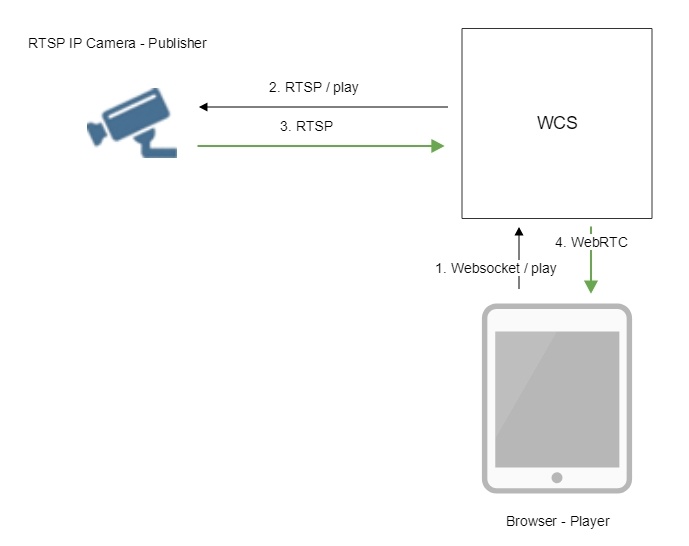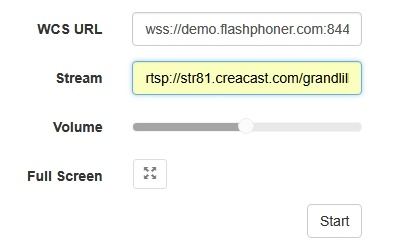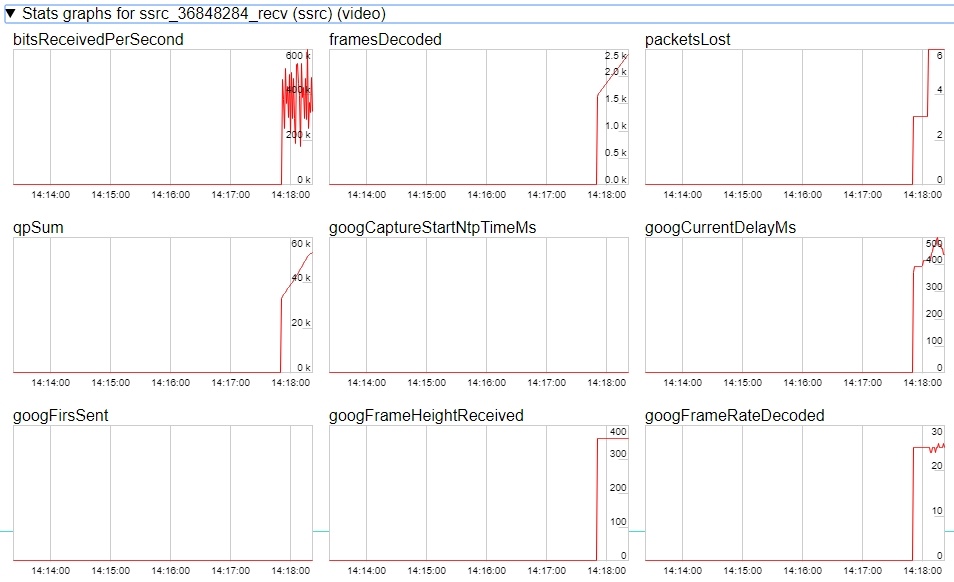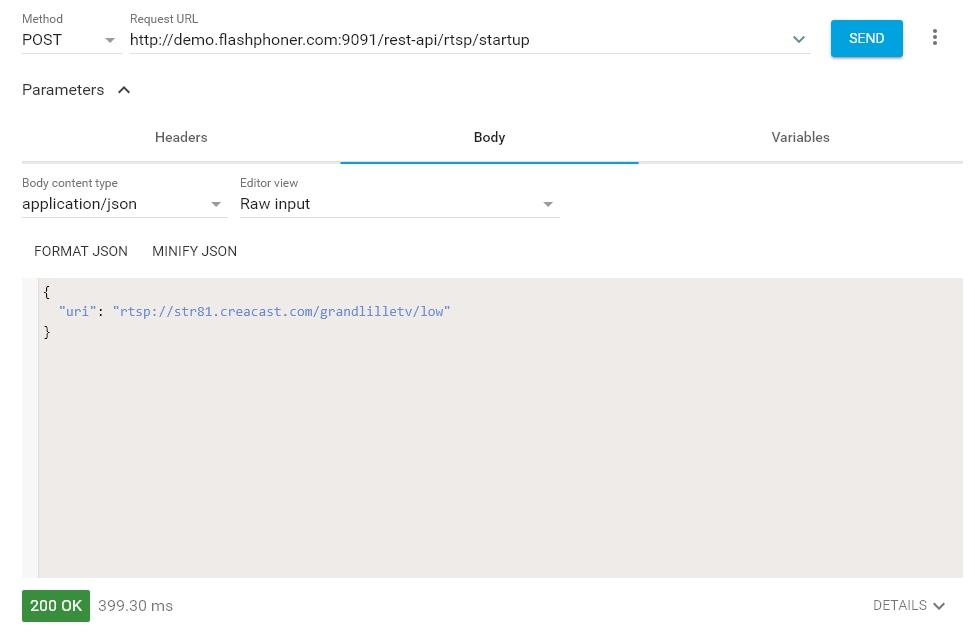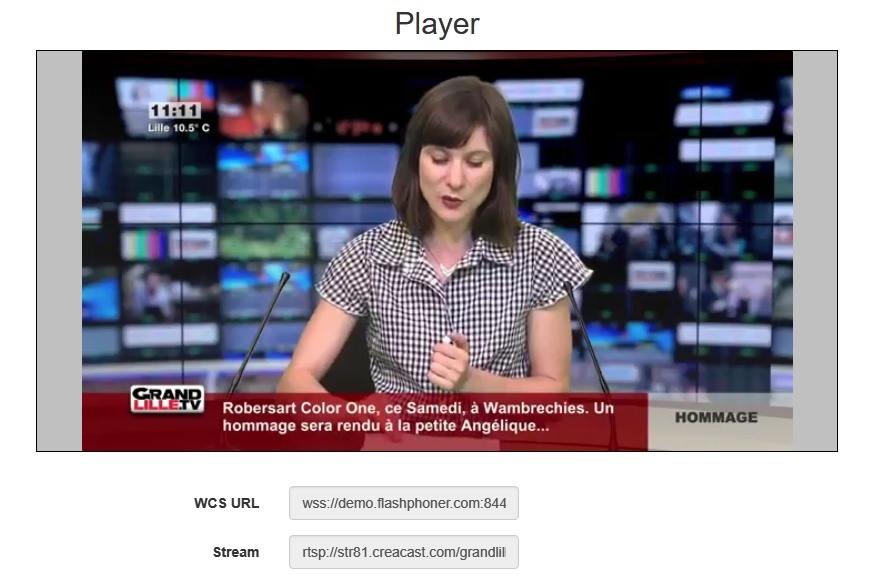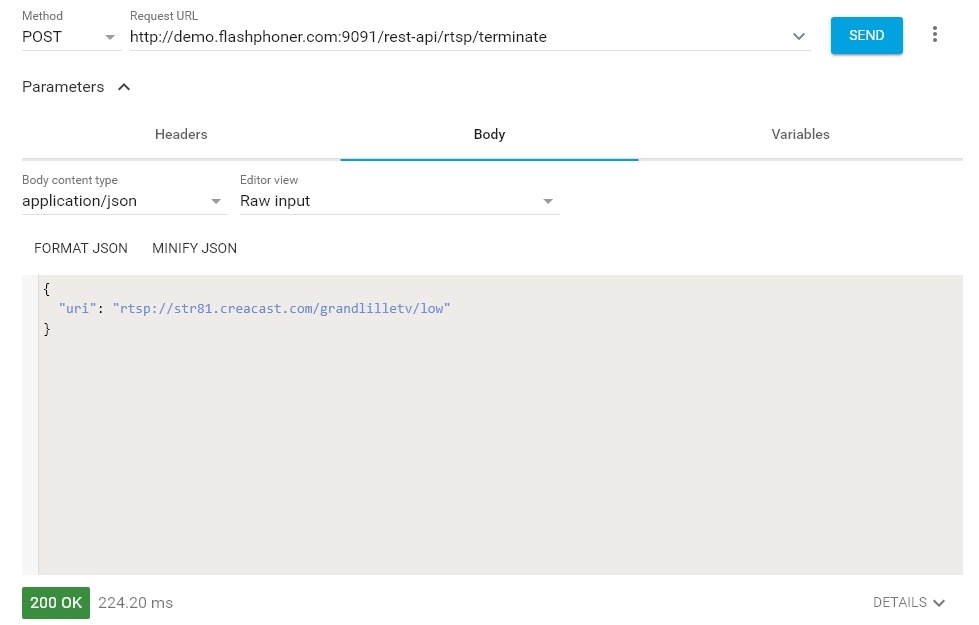| Table of Contents |
|---|
Overview
A video stream is captured from an RTSP source that provides audio and video in the supported codecs. Then, the server transforms this video stream for playing in browsers and mobile devices.
RTSP sources
- IP cameras
- Media servers
- Surveillance systems
- Conference servers
Supported codecs
- H.264
- VP8
- AAC
- G.711
- Speex
Supported platforms and browsers
...
Chrome
...
Firefox
...
Safari 11
...
Internet Explorer
...
Windows
...
+
...
+
...
+
...
Mac OS
...
+
...
+
...
+
...
Android
...
+
...
+
...
iOS
...
-
...
-
...
+
Operation flowchart
1. The browser establishes a connection to the server via the Websocket protocol and sends the play command.
2. The server connects to the RTSP source and send the play command.
3. The RTSP source sends the RTSP stream to the server.
4. The server transforms the stream to WebRTC and gives the stream to the browser.
Configuration
Sometimes, when IP camera should be connected through VPN, RTSP client should be bound to certain IP address. The option rtsp_client_address in settings file flashphoner.properties defines this address, for example:
| Code Block | ||||
|---|---|---|---|---|
| ||||
rtsp_client_address=172.16.0.3 |
Quick manual on testing
Capturing of a video stream from the IP camera and playing it in a browser
1. For this test we use:
- the demo server at demo.flashphoner.com;
- the Player web application to play the captured stream in the browser.
2. Open the Player web app and specify the URL of the camera in the "Stream" field:
3. Click the "Start" button. Broadcasting of the captured stream begins.
4. WebRTC internals diagrams:
Stream capture from the IP camera management by REST API
Usually, it is enough to set the camera URL as stream name to capture stream from IP camera. However, it is possible to manage RTSP stream capture by REST API if necessary.
Testing
1. For this test we use:
- the demo server at demo.flashphoner.com;
- the Chrome browser and the REST-client to send queries to the server;
- the Player web application to play the captured stream in the browser.
2. Open the REST client. Send the /rtsp/startup query specifying the URL of the web camera in parameters:
3. Make sure the stream is captured by the server. To do this, send the /rtsp/find_all query:
4. Open the Player web app and in the "Stream" field specify the URL of the web camera and click Start. Browser starts to play the stream:
5. Send the /rtsp/terminate query specifying the URL of the web camera in parameters:
6. Stream playback will terminate displaying an error:
REST-queries
A REST-query should be HTTP/HTTPS POST request as follows:
- HTTP: http://test.flashphoner.com:8081/rest-api/rtsp/startup
- HTTPS: https://test.flashphoner.com:8444/rest-api/rtsp/startup
Where:
- test.flashphoner.com - is the address of the WCS server
- 8081 - is the standard REST / HTTP port of the WCS server
- 8444 - is the standard HTTPS port
- rest-api - is the required part of the URL
- /rtsp/startup - REST-method to use
REST-methods and response statuses
...
REST-method
...
Example of REST-query
...
Example of response
...
Response statuses
...
Description
...
/rtsp/startup
...
| Code Block | ||||
|---|---|---|---|---|
| ||||
{
"uri":"rtsp://myserver.com/live/myStream"
} |
409 - Conflict
500 - Internal error
Pull the RTMP stream by the specified URL
...
/rtsp/find_all
...
| Code Block | ||||
|---|---|---|---|---|
| ||||
{
"uri": "rtsp://myserver.com/live/myStream",
"status": "PLAYING"
} |
200 – streams found
404 – streams not found
...
Find all pulled RTMP-streams
...
/rtsp/terminate
...
| Code Block | ||||
|---|---|---|---|---|
| ||||
{
"uri":"rtsp://myserver.com/live/myStream"
} |
200 - stream terminated
404 - stream not found
...
Terminate the pulled RTMP stream
Parameters
...
Parameter name
...
Description
...
Example
...
uri
...
URL of the RTSP stream
...
rtsp://myserver.com/live/myStream
...
status
...
Current status of the stream
...
PLAYING
Call flow
Below is the call flow when using the Player example
1. Establishing a connection to the server.
Flashphoner.createSession(); code
| Code Block | ||||
|---|---|---|---|---|
| ||||
Flashphoner.createSession({urlServer: url}).on(SESSION_STATUS.ESTABLISHED, function(session){
setStatus(session.status());
//session connected, start playback
playStream(session);
}).on(SESSION_STATUS.DISCONNECTED, function(){
setStatus(SESSION_STATUS.DISCONNECTED);
onStopped();
}).on(SESSION_STATUS.FAILED, function(){
setStatus(SESSION_STATUS.FAILED);
onStopped();
}); |
2. Receiving from the server an event confirming successful connection.
ConnectionStatusEvent ESTABLISHED code
| Code Block | ||||
|---|---|---|---|---|
| ||||
Flashphoner.createSession({urlServer: url}).on(SESSION_STATUS.ESTABLISHED, function(session){
setStatus(session.status());
//session connected, start playback
playStream(session);
}).on(SESSION_STATUS.DISCONNECTED, function(){
...
}).on(SESSION_STATUS.FAILED, function(){
...
}); |
3. Request to play the stream.
session.createStream(), stream.play(); code
IP camera URL is passed to createStream() method as stream name
| Code Block | ||||
|---|---|---|---|---|
| ||||
function playStream(session) {
var streamName = $('#streamName').val();
var options = {
name: streamName,
display: remoteVideo,
flashShowFullScreenButton: true
};
...
stream = session.createStream(options).on(STREAM_STATUS.PENDING, function(stream) {
...
});
stream.play();
} |
4. Request from WCS to the RTSP source to broadcast the stream.
5. Broadcasting the RTSP stream
6. Receiving from the server an event confirming successful capturing and playing of the stream.
StreamStatusEvent, статус PLAYING code
| Code Block | ||||
|---|---|---|---|---|
| ||||
stream = session.createStream(options).on(STREAM_STATUS.PENDING, function(stream) {
...
}).on(STREAM_STATUS.PLAYING, function(stream) {
$("#preloader").show();
setStatus(stream.status());
onStarted(stream);
...
});
stream.play();
|
7. Sending audio- and video stream via WebRTC
8. Stopping playing the stream.
stream.stop(); code
| Code Block | ||||
|---|---|---|---|---|
| ||||
function onStarted(stream) {
$("#playBtn").text("Stop").off('click').click(function(){
$(this).prop('disabled', true);
stream.stop();
}).prop('disabled', false);
$("#fullScreenBtn").off('click').click(function(){
stream.fullScreen();
}).prop('disabled', false);
$("#volumeControl").slider("enable");
stream.setVolume(currentVolumeValue);
} |
9. Receiving from the server an event confirming successful stop of the stream playback.
StreamStatusEvent, статус STOPPED code
| Code Block | ||||
|---|---|---|---|---|
| ||||
stream = session.createStream(options).on(STREAM_STATUS.PENDING, function(stream) {
...
}).on(STREAM_STATUS.PLAYING, function(stream) {
...
}).on(STREAM_STATUS.STOPPED, function() {
setStatus(STREAM_STATUS.STOPPED);
onStopped();
}).on(STREAM_STATUS.FAILED, function(stream) {
...
}).on(STREAM_STATUS.NOT_ENOUGH_BANDWIDTH, function(stream){
...
});
stream.play(); |
RTSP connection reuse
If other subscrubers request the stream captured from RTSP IP camera, the previous RTSP connection will be used if all subscribers set the same camera URL. For example, two requests to the same IP camera
| Code Block | ||||
|---|---|---|---|---|
| ||||
rtsp://host:554/live.sdp |
and
| Code Block | ||||
|---|---|---|---|---|
| ||||
rtsp://host:554/live.sdp?p=1 |
are differ, then two RTSP connections will be created if streams from both URLs are requested.
Stream capture authentication
WCS supports RTSP stream capture authentication by user name and password, user data should be set in stream URL, for example
| Code Block | ||||
|---|---|---|---|---|
| ||||
rtsp://user:password@hostname/stream |
If name or password contains any special characters, they should be escaped such as
| Code Block | ||||
|---|---|---|---|---|
| ||||
rtsp://user:p%40ssword@hostname/stream |
Where
- user is user name
- p@ssword is password with character '@', it is escaped in URL.
Known issues
...
5. Connection to the IP camera is lost on error in any track (audio or video)
Symptoms: connection to the IP camera is lost if one of tracks returns error 4**.
Solution: this behavior is enabled by default. However if one-time errors are not critical and should not terminate broadcasting, in the flashphoner.properties files set
| Code Block | ||||
|---|---|---|---|---|
| ||||
rtsp_fail_on_error_track=false
rtp_force_synchronization=true |
6. All the characters in a stream name, that are not allowed in URI, should be escaped
Symptoms: RTSP stream is not played with 'Bad URI' error
Solution: any character that is not allowed in URI, should be escaped in stream URL, for example
| Code Block | ||||
|---|---|---|---|---|
| ||||
rtsp://hostname/c@@lstream/channel1 |
should be set as
| Code Block | ||||
|---|---|---|---|---|
| ||||
rtsp://hostname/c%40%40lstream/channel1 |
7. Some IP cameras do not support cnonce field in RTSP connection message header.
Symptoms: RTSP stream is played with VLC, but is not played with WCS.
Solution: set the following parameter in flashphoner.properties file
| Code Block | ||||
|---|---|---|---|---|
| ||||
rtsp_auth_cnonce= |
with empty value.
| Include Page | ||||
|---|---|---|---|---|
|
